
Equipment
Truck Checks: February 2010
fire truck’s suspension system has three main functions. The first is fairly obvious – to support the weight of the truck. The second is to cushion the truck chassis when travelling over rough roads.
February 17, 2010
By Don Henry
fire truck’s suspension system has three main functions. The first is fairly obvious – to support the weight of the truck. The second is to cushion the truck chassis when travelling over rough roads. The third function is not so obvious, and is often overlooked: to transfer the torque of the engine and the braking force to the frame.
Because the axles, brakes and suspensions on fire trucks are not designed for excess overloads it is important to learn how to check your suspension systems properly in order to avoid the dangers and expense of a malfunction.
■ 1. Supporting the weight of the truck
A unique feature of the operation of a fire truck is the fact that it spends almost 100 per cent of its service life fully loaded, or, in some cases, dangerously overloaded. Take, for example, a gravel truck; the owners would be ecstatic if the gravel truck could reach a 50 per cent loaded life cycle. A fire truck may, on rare occasion, return to the fire hall with less than a full water tank but, for the most part, it is fully loaded. As a safety note, many departments have an SOP that any truck returning to the hall must empty its water tanks. Even with a properly designed and baffled water tank, a less-than-full water tank can have an un-stabilizing effect. This near 100 per cent load service can cause the truck’s springs to sag over time.
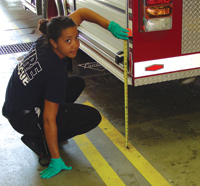 |
|
| Photo 1. EST student measuring bumper to road distance. Make sure that the truck is at operational weight minus driver and crew. Record that measurement and then you will be able to refer back to it if you suspect a spring sag problem. |
|
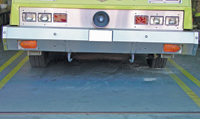 |
|
| Photo 2. Example of spring sag. Note the door bar at bottom of picture is level; the truck’s bumper is not. |
|
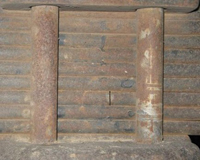 |
|
| Photo 3. Broken rear spring. |
|
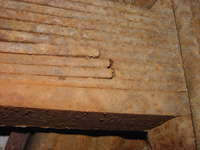 |
|
| Photo 4. This was only found after a thorough washing; note broken leaf third from bottom. |
|
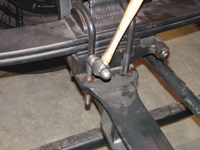 |
|
| Photo 5. Rap on u-bolt to find loose bolt. Note: do not hit bolt threads. | |
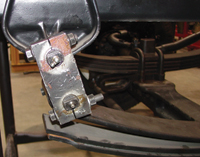 |
|
| Photo 6. Typical grease zerks; rear spring hanger on the front axle. Advertisement
|
I recommend that as part of a yearly inspection of your truck you measure the distance from a point on the bumper to the floor in your fire house. Of course, make sure all the tires are up to correct pressure and the floor is level. Front right springs (passenger side) tend to sag more than front left springs. This is because of the opposite reaction of the engine torque when the truck is under accelerating. While there are very few trucks with manual transmissions, this condition is often more evident on these trucks than on trucks equipped with automatic transmissions. The truck could, of course, simply be overloaded or misloaded. If more weight is on the rear axle, the front axle will not contact the ground with enough force for effective steering. If too much weight is on the front axle, the amount of braking force will be reduced as most of the braking is done with the rear axle(s).
NFPA 1911 recommends that the side-to-side load not vary by more than seven per cent. If, say, a hydraulic ladder were installed on the passenger side of the truck, it may be necessary to balance that load with a load on the driver’s side to stay within the seven per cent side-to-side load.
Of course, you could have a broken spring; this is very common on trucks that see severe service or are overloaded. After you have given the springs a good wash, look for broken spring leafs, thoroughly wash the springs and, with a strong light, inspect the springs. Photos 3 and 4 are pictures of typical broken springs. It is not uncommon for a broken spring to turn sideways and rip into the side of a tire, so fix this right away.
Springs can also break if the u-bolts holding the spring to the axle are not properly torqued. While a small hammer will not replace a torque wrench to test for properly torqued u-bolts, it does give a good indication of a loose or broken bolt.
While you are under the truck on your creeper, give the spring pins and shackle bushings a good greasing. A spring pin and bushing that will not accept grease needs to be taken to a shop and repaired. You should use a grease of an NLGI (National Lubrication Grease Institute) 2 grade. Use the grease type recommended by the manufacturer but, if that information is not available, I prefer to use a grease with an Extreme Pressure MOLY additive (molybdenum disulfide). This grease is not the type that you should use for the high-speed bearings in the fire pump.
The grease zerks must be clean and free of any dirt or you will be injecting this dirt in with the grease and creating a very effective grinding compound in between the spring pin and bushing. Three to four shots of grease from the gun should be enough; any more and the grease will flow out of the bushing onto the floor. Wipe up excess grease. If the front spring shackle pins are seized from lack of grease, the truck will have a very harsh ride.
■ 2. Cushioning the truck chassis
The second function of a suspension system is to cushion the truck’s ride.
Many modern fire trucks have front and rear hydraulic shock absorbers to accomplish this. Hydraulic shock absorbers are used to control body sway and wheel bounce and to reduce spring breakage by damping spring oscillations.
Take a good look at the shock absorbers while you’re down on the creeper, as they are very important for the stability and road handling of the truck. A small amount of dust on the lower half of the shock absorber is normal and does not indicate a problem. It is normal for a small amount of oil mist to be displaced by the shock over time. This oil mist will attract dust and it can be wiped off. If you notice oil dripping from the shock then the shock needs to be replaced. On a smaller vehicle like a half ton it is possible to jump up and down on the front or rear bumper and then notice how many up-and-down oscillations of the bumper it takes for the shock to dampen the movement and bring the bumper to a stop. This, of course, is not practical on a large fire truck. One good indicator of shock absorber operation is to drive the truck over a fairly rough road, then stop the truck and feel the lower half of the shock; if it’s warmer than the metal in the frame it’s doing its job. Heat is created in the hydraulic oil inside the shock absorber as the shock absorber tries to dampen the oscillations of the springs. This is why the lower body of the shock absorber gets warm. If the hydraulic oil has leaked out then the shock absorber will not get warm. Be careful not to burn your hand when checking the absorbers. Shock absorbers are a very important component of the truck’s suspension system and are no longer just nice-to-have options. One further tip: If one shock with years of service is found to be defective I strongly recommend that the other shocks also be changed. This will ensure a well-balanced system.
■ 3. Transferring the torque to the frame
The third function of the suspension system is to transfer the torque of the engine and the braking force to the frame.
Many people think that, after the engine, transmission, driveshaft, differential, axles and wheels have delivered the power to the road, their job is done and the truck travels down the road: wrong. This is a prime example of Newton’s third law of motion – for every action there is an equal and opposite reaction.
After the power is delivered from the tires to the road, the reaction force is transferred to the rear axle and then to the frame, in many cases through the springs, spring brackets, u-bolts and torque arms.
If these components cannot transfer this torque back to the frame, the truck does not move down the road and the springs, axles and driveshaft will simply wrap up under the truck. If you think that’s scary, think of this: the truck braking system has to absorb far more energy than the engine ever had to deliver to the wheels – about six to 10 times more. This is simply physics; you want to stop the truck faster than you accelerated, correct? As the brakes are applied, the forward energy of the truck (mass x speed) must be converted back to heat at the brakes. But if the truck has defective springs or spring pins, when the brakes are applied, the axle will stop, separate from the truck frame and the truck will continue down the road. Make sure you have your seatbelt on if this happens!
Some of you may be under the illusion that it’s OK to operate an overloaded fire truck – in other words, a truck that exceeds its GVWR (Gross Vehicle Weight Rating). The axles, brakes and suspensions are not designed for excess overloads. If you think the truck manufacturer installed larger components than you paid for, think again. If you believe that some type of permit from a provincial government highway agency can repeal the laws of physics, you’re sadly mistaken. In fact, the next time you ask for this overload permit, ask the agency if it will indemnify you, your chief and your fire department if you kill someone because your truck was overloaded and they gave you permission to operate an overloaded and unsafe truck.
Don Henry teaches the Automotive Services Technician and Heavy Equipment Technician programs at Lakeland College in Vermilion, Alta. He can be reached at don.henry@lakelandcollege.ca
Print this page